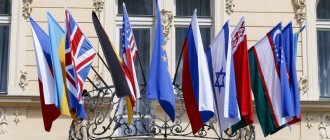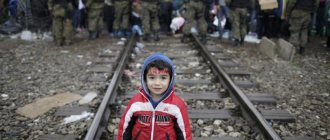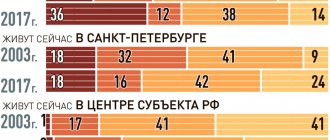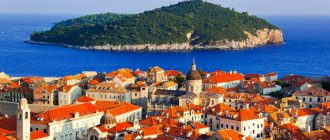Definition of concepts
Before delving into the topic, we suggest studying the minimal terminology. It is extremely important not to confuse the following concepts:
- Migration is the relocation of a group of citizens from one state to another or from one locality in the country to another. In most cases, large numbers of people are transported over long distances;
- Balance - the difference between the number of arriving and departing population to a certain territory for a specific (same) period of time;
- Statistics - organized and processed data obtained from population surveys and legal documents. They clearly show the “migration picture” of a regional object;
- A refugee is a migrant who fled his or her country due to emergency circumstances, such as natural disasters, political unrest, or any other life-threatening circumstances.
Types of migrations
Considering the different characteristics of migration, we can imagine different classifications of this phenomenon. First of all, there are:
- Internal. This type involves the resettlement of people within their native country. For example, from one city to another, from city to village, from village to city;
- External. Moving to another country. This could be either a neighboring state or one located on the other side of the globe. Then you will have to cross more than one border.
From the point of view of legal status, migration is viewed differently:
- Legal. Citizens stay and work in a foreign country legally;
- Illegal. It involves illegally crossing the border in order to find a place to live and work in another state.
According to other criteria:
- Temporary;
- Irrevocable;
- Nomadism/pilgrimage;
- Forced migration.
Migration cannot be attributed to only one type. Thus, it can be simultaneously external, legal, forced and temporary.
Historical reference
The phenomenon of migration is a natural process that regulates the social, demographic and economic spheres of society.
This has a positive effect on the receiving party, since the migrant brings net profit to the state, solves the problem of employment, and contributes to the integration of culture. But there are also negative aspects to migration. This is evidenced by sad experiences in history, when migration was forced and repressive. Here are some of them:
- Migration of the population during the Civil War in Russia (1918-1922). About 3 million Russians sought to find a place for themselves in other countries of the world;
- Mass migrations during the Chilean Revolution in the 70s;
- Total “preventive deportations” of Soviet Germans in the post-war years, one of the examples of Stalinist repressions. Greeks and Finns were also forced to migrate;
- Forced deportation of national minorities (peoples of the USSR). This category included Azerbaijanis, Crimean Tatars, Poles, Chinese, Armenians, Jews, etc.
Read also: External migration
The legislation of the Russian Federation recognizes 2 types of forced immigrants: refugees and forced migrants . They differ in their civil status. Refugees are citizens of other countries, migrants are citizens of the Russian Federation.
Legal regulation
The main law that should be followed is Decree of the Government of the Russian Federation No. 935 “On clarification of the Federal Migration Program.”
The document contains information on the principle of considering various types of migration from the legal side of the issue. The topic of forced migration is touched upon. Citizens of the USSR and post-Soviet countries are recognized as a special category of citizens.
The issue of forced migrants is discussed in detail in another legal document, Law No. 4530-I “On Forced Migrants” of 1993.
In particular, Article 3 talks about the procedure for recognizing migrant status. Article 6 describes the rights and obligations of the migrant in the state. Article 14 raises the issue of international cooperation on the problems of refugees and internally displaced persons.
Decree of the Government of the Russian Federation of August 3, 1996 No. 935 “On clarification of the Federal Migration Program”
Law of the Russian Federation of February 19, 1993 No. 4530-I “On forced migrants”
Main reasons for migration
Depending on the origin, migrations can occur due to national problems, economic difficulties, environmental disasters, political and military unrest.
Issues of religion, law and humanitarianism arise sharply. Some migrations are of a group nature, others are individual. The list of reasons why they occur in society is also not universal. The basis for migration can be special and standard, objective and subjective.
Important! To understand what pushes people to leave the country, or for what reasons the state takes measures to resettle them, it is necessary to take into account the characteristics of economic development and specific social factors of a particular territory.
Particular attention should be paid to the issue of the environmental situation and the level of environmental pollution. The conducted studies revealed a pattern between morbidity due to environmental pollution and migration activity of the population.
For clarity, we will collect the reasons into a single list:
- desire to improve the quality of life;
- the desire to find a better-paid job, to obtain the desired specialty, to find suitable working conditions in another country due to the impossibility of obtaining this in one’s native state;
- need for a different climate for health reasons;
- spiritual need for knowledge of another culture, new impressions and knowledge;
- worsening military and ethnic sentiments in the country;
- persecution of a person.
The reason for forced eviction is only an emergency situation related to a threat to life. In this case, no one will ask citizens about their desire to move; the process takes place forcibly. The state provides social support to migrants and takes responsibility for providing comfortable living conditions.
Features of external and internal migration in Russia (page
Migration (from the Latin “migration”) is the movement of people between individual territories and settlements associated with a permanent, temporary or seasonal change of their place of residence. The main reason for migration is economic, but political, national, religious and other reasons also play a significant role. The forms of migration are very diverse: every day hundreds of millions of people participate in pendulum (shuttle) work trips due to the large distance between people’s places of residence and work; the scope of seasonal movements is large, associated with seasonal work, trips for recreation and treatment, tourism, as well as religious pilgrimages to holy places.
And, nevertheless, the main flows of internal migration were determined by the processes of urbanization, industrialization and economic development of territories rich in mineral resources. They are associated, first of all, with the development of the Far North and Siberia, the construction of the Baikal-Amur Mainline, etc. Economic incentives generated intense migration to development zones, and difficult living conditions generated an almost equally intense return flow. Proposals for the economic development of these territories on a rotational basis, i.e. without permanent settlement, were never accepted, although the low efficiency of migration (poor survival rate of new settlers) and the high mortality rate in development zones proved the validity of such proposals.
We recommend reading: How to purchase a plot of land for free
The scale of the situation in Russia
The time of repression of the “kulaks” and deportations of minorities is behind us.
The level of internal migration has decreased markedly. But interethnic relations have worsened and racial conflicts have become more frequent. This has led to an increase in non-repressive migration.
In connection with recent events in Ukraine, the Federal Migration Service (Office of the Federal Migration Service) has to consider a large number of applications for refugee status or temporary asylum.
Read also: Business in Spain
The number of emigrants (people leaving the country) is growing in Russia. Citizens who are unable to accept the unstable economic and political situation most often choose countries to move to such as the USA, Germany, and Israel.
There is a high level of illegal immigration from neighboring countries. These people come to the Russian Federation to earn money, breaking the law even when entering the border.
In internal migration, a large influx to regions with high wages and living standards is obvious: Moscow and the Moscow region, St. Petersburg, Kaliningrad region. Natural and climatic conditions seem no less important for Russians, which is why Krasnodar and Stavropol Territories have become popular regions for immigrants.
Scientific and educational portal IQ
Speaking about stimulating internal labor mobility in the Russian Federation, Zh. Zayonchkovskaya noted that statements about the relocation of workers from regions with severe unemployment to where labor resources were really needed were met with the reluctance of the regions to accept “guests” (as it turned out, most workers were needed in Moscow region). With regret, Zayonchkovskaya noted the failures of the small business support program: “in the conditions of this crisis, it could have produced real results.”
We recommend reading: Plot for 3 children in the Volgograd region
For example, registration and permanent registration mechanisms require improvement. Optional de jure, this condition in practice becomes a stumbling block in the employment of migrants, including domestic migrants, in their receipt of full medical care, bank loans, etc.
Problems and consequences of the process
Donor states experience the negative consequences of migration.
Among those leaving, the working-age young population predominates. It follows from this that elderly and disabled citizens remain in the donor country, which undermines the economy of the region. But problems also arise for the acceptor: refugees need to be resettled, employed, and provided with social protection and medical care. If the flow of immigrants is large, then it is simply impossible to create comfortable conditions for them in a short time.
The receiving party may experience the negative consequences of overcrowding caused by forced migration - a decrease in living standards, unemployment, conflicts between native and migrant residents, and an increase in crime.
Examples of forced migration
Mass migration to the Russian Federation occurred in the first half of the nineties.
Population growth peaked in 1993 and then declined. By 2001, the trend had moderated. Since 1992, registration of refugees and displaced persons began. Over the entire period, 1.4 million people were registered. After citizens adapt to the new state, their special status is removed.
Interesting! In 1992, the FMS began its activities in Russia.
The majority of refugees before 1995 were from Tajikistan. Slightly less from Georgia and Azerbaijan.
Another massive group of emigrants is from the Chechen Republic. From December 1994 to January 1995, almost 260,000 people left. Subsequently, some returned back.
During the disaster at the Chernobyl nuclear power plant, the state carried out migration measures in an organized manner and tried to accommodate residents in new places as much as possible.
In 2021, an example of forced migration is the resettlement of people from the Eastern part of Ukraine to Russia due to military operations.
Now there is a decline in migration both in Russia and throughout the world. Due to the increasing frequency of terrorist attacks, many countries around the world are forced to tighten migration controls. Russia is also taking unprecedented security measures.
Illegal stay
It is a mistake to believe that forced migration is the same as illegal migration.
But they are connected to each other. Most migrants are in no hurry to legitimize their status in the receiving state. Usually a citizen arrives under a visa-free regime and registers. The more difficult it is to complete the procedure, the more illegal residents there are in the country.
Note! Illegal stay in the country makes it difficult to find a job.
In 2015, a new procedure for the legalization of migrants was introduced. But for its effectiveness, coordination of the work of all government institutions and a 2-sided agreement with other countries, primarily with neighboring countries, is required.
Read also:Visa-free countries for Russians in 2021
Models of response to migration
The state or region receiving migrants has the following ways of responding to entry:
- absolute exception. This is the migration policy of states that completely prohibit entry into the country.
- segregation or selective exclusion. Migration policy, which is characterized by allowing entry into the country of certain categories of the population necessary to solve the internal problems of the host country for a certain period of time. Most often, this is permission to enter for employment in order to provide labor for production in the host country.
- assimilation. This is permission to enter the country and pursue a policy of integrating the visiting population into society.
- pluralism. It is also characterized by the possibility of entry into the country for various categories of the population. Migrants are identified as a separate social group, having equal rights with the main population.
Need advice on your academic work? Ask a question to the teacher and get an answer in 15 minutes! Ask a Question










